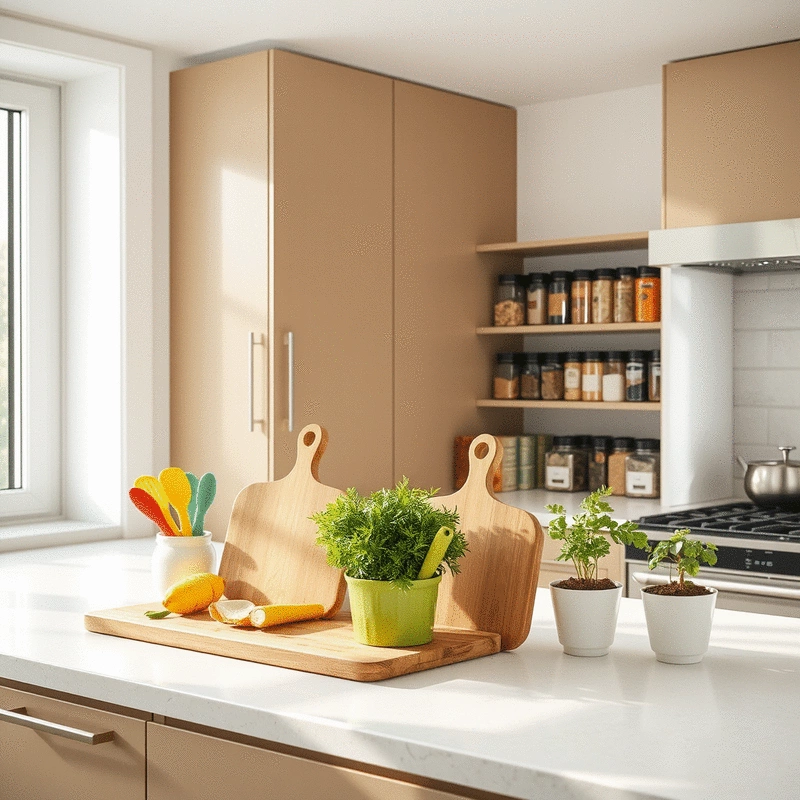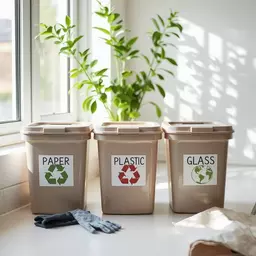Keep Your Kitchen Clutter-Free

Have you ever walked into a kitchen that feels like a breath of fresh air? A clutter-free kitchen can be that sanctuary, elevating your cooking experience and turning meal prep into a delight rather than a chore. The following strategies will empower you to transform your space and habits for a more organized kitchen.
What You Will Learn
- Establish functional cooking zones to streamline meal preparation.
- Organize your pantry effectively for easier access to ingredients.
- Embrace a minimalist kitchen design to reduce distractions and clutter.
- Implement systematic purging tactics to keep only what you truly need.
- Adopt sustainable maintenance routines to preserve your clutter-free space.
- Take actionable steps towards your kitchen organization goals with community support.
Key Strategies for a Clutter-Free Kitchen
Discover the essential strategies for maintaining a clutter-free kitchen, focusing on zone creation, pantry organization, and maintenance routines. If you're wondering whether to tackle decluttering yourself or seek professional help, consider exploring the benefits of DIY decluttering vs. expert help to make an informed decision for your home.
Establishing Functional Kitchen Zones
- Cooking Zone: Keep essential cookware close.
- Prep Zone: Designate space for chopping and mixing.
- Baking Zone: Organize baking essentials for efficiency.
Organizing the Pantry for Easy Access
- Label Everything: Use clear labels on bins.
- Group Similar Items: Keep like items together.
- Use Clear Containers: Visibility makes access easier.
Implementing Maintenance Routines
- 10-Minute Tidy-Up: Daily quick clean sessions.
- Monthly Review: Reassess kitchen items monthly.
- Donation Box: Keep a box for items to donate.
Decluttering Tactics for Long-Term Success
- Start Small: Tackle one area at a time.
- Ask Yourself: If unused in a year, consider letting go.
- Sort Items: Keep, donate, and recycle piles.
Effective Strategies for Maintaining a Clutter-Free Kitchen
Understanding the Importance of a Decluttered Kitchen
Imagine stepping into a kitchen where everything has its place, and the chaos of clutter is nowhere to be found! A clutter-free kitchen can significantly improve your efficiency while cooking and enhance the overall aesthetics of your space. Not only does this create a serene environment, but it also makes meal prep feel more enjoyable and stress-free.
When your kitchen is organized, you can find what you need quickly. This helps save time during busy weeknights when you want to whip up a delicious meal without the hassle of searching for ingredients. Plus, a clean and neat kitchen can inspire healthier eating habits, as it becomes a welcoming space for cooking and gathering! For more tips on maintaining an organized home, explore simple ways to organize your living room.
Establishing Functional Kitchen Zones
Creating Work-Friendly Cooking Zones
To streamline your cooking process, it's essential to establish specific areas for different tasks. Consider creating zones for cooking, prepping, and baking. Here’s how you can get started:
- Cooking Zone: Keep essential cookware and utensils within arm's reach, making it easy to sauté, boil, or grill.
- Prep Zone: Designate a clear countertop space for chopping and mixing, ideally near your sink for easy cleanup.
- Baking Zone: Organize baking sheets, mixing bowls, and measuring cups together for efficient baking sessions.
By having these zones, you can eliminate the unnecessary back-and-forth movements, ultimately enhancing your cooking efficiency. The goal is to create a workflow that feels smooth and intuitive.
Organizing the Pantry for Easy Access
Next, let’s talk about your pantry! An organized pantry can be a game changer when it comes to meal planning and grocery shopping. Here are some strategies to keep it neat:
- Label Everything: Use clear labels on your bins and containers to identify contents quickly.
- Group Similar Items: Keep canned goods, snacks, and baking supplies together for easy retrieval.
- Use Clear Containers: Invest in transparent storage containers so you can see what's inside at a glance.
By adopting these habits, you’ll find that meal prep becomes much easier and more enjoyable. Plus, you’ll be able to make the most of your grocery shopping, reducing waste and saving money!
Embracing Minimalism in Kitchen Design
Minimalism isn’t just a design trend; it’s a way to cultivate a peaceful environment in your kitchen. By embracing a minimalist approach, you can remove distractions and keep only the essentials. This means fewer items to manage, reducing visual clutter and allowing for a more functional space. Learn more about effective ways to declutter your home to expand this philosophy throughout your living space.
Consider investing in quality cookware and utensils that you truly love and use. It’s better to have a few high-quality items instead of a cluttered collection gathering dust. The calm aesthetic of a minimalist kitchen can also encourage mindful cooking and eating habits!
Decluttering Tactics for Long-Term Success
Systematic Purging of Unnecessary Items
One of the keys to a clutter-free kitchen is *regularly assessing* your items. Here’s a simple guide to help you through the purging process:
- Start Small: Choose one kitchen area, like a drawer or a shelf, to tackle first.
- Ask Yourself: If you haven’t used it in the past year, consider letting it go.
- Sort Items: Create three piles: keep, donate, and recycle. Be honest with yourself!
By systematically purging unnecessary items, you’ll create space for the things that truly matter. This process doesn’t have to be overwhelming—take it one step at a time!
Implementing Maintenance Routines
Once you’ve decluttered, it’s essential to maintain that organization! Here are some sustainable maintenance tips:
- 10-Minute Tidy-Up: Spend just ten minutes daily tidying up your kitchen. Set a timer and make it fun!
- Monthly Review: At the end of each month, review your kitchen items and remove anything that doesn't belong.
- Keep a Donation Box: Place a box in your pantry or closet where you can easily toss items you no longer need.
These small, consistent efforts can make a big difference in maintaining a clutter-free kitchen over time. Remember, it’s not about perfection; it's about progress!
Pro Tip
Did you know? Incorporating a "One In, One Out" rule can be a game-changer for maintaining a clutter-free kitchen. For every new item you bring into your kitchen, consider removing an old or unused item. This simple strategy helps prevent clutter from accumulating and keeps your space organized.
Frequently Asked Questions About a Clutter-Free Kitchen
- Q: Why is a clutter-free kitchen important?
- A: A clutter-free kitchen improves efficiency during cooking, enhances the overall aesthetics of your space, makes meal prep more enjoyable, and can inspire healthier eating habits.
- Q: How can I establish functional kitchen zones?
- A: Create specific areas for different tasks: a cooking zone for essential cookware, a prep zone for chopping and mixing, and a baking zone for baking essentials. This streamlines your workflow.
- Q: What are key strategies for organizing my pantry?
- A: Label everything, group similar items together (e.g., canned goods, snacks), and use clear containers for better visibility and easier access.
- Q: What does embracing minimalism in the kitchen involve?
- A: Minimalism means removing distractions and keeping only essential, high-quality items. This reduces visual clutter and promotes a more functional, peaceful space.
- Q: How can I maintain a clutter-free kitchen long-term?
- A: Implement systematic purging (e.g., the "one-year rule") and regular maintenance routines like a 10-minute daily tidy-up, monthly reviews, and keeping a donation box for unused items.
Recap and Next Steps for a Clutter-Free Kitchen
As we wrap up our exploration of maintaining a clutter-free kitchen, it’s important to reflect on the key strategies we've discussed. A decluttered kitchen not only enhances the aesthetics of your home but also improves efficiency in your daily cooking routines. By establishing functional zones, organizing your pantry, and embracing a minimalist approach, you create a serene space that invites creativity and joy into meal preparation.
Remember, the core strategies we covered include:
- Creating work-friendly cooking zones to streamline your workflow.
- Organizing the pantry for easy access, making meal prep faster and more enjoyable.
- Implementing maintenance routines that keep clutter at bay over time.
It’s all about taking small, actionable steps that lead to long-term success. As someone who’s passionate about creating organized and inviting homes, I believe that with dedication and the right strategies, you’ll see a transformation in your kitchen space.
Encouraging Action: Implementing Your Kitchen Plan
Now that you've gathered insights on how to create a clutter-free kitchen, it's time to take action! Start by outlining your plan and identifying specific areas you wish to improve. Using the resources provided, such as downloadable checklists and workbooks, will make this process feel even more manageable. Here are some actionable steps you can take:
- Choose a day to tackle one zone at a time in your kitchen.
- Use the Clutter-Free Starter Kit for quick wins and motivation as you declutter.
- Engage with our community for support and encouragement—share your progress as you go!
Remember, the goal isn’t perfection but rather progress toward a more organized and sustainable kitchen. Every small step counts, and you’re on your way to making your kitchen a calm and inviting sanctuary.
Inviting Feedback and Sharing Experiences
I’d love to hear about your experiences as you embark on this journey toward a clutter-free kitchen! What tips or strategies have worked for you? Feel free to share your thoughts and insights in the comments section below. Your stories not only inspire others but also help build a supportive community here at Simply Renewed Home. For more detailed guidance, consider how to declutter your living space easily across your entire home.
So, let’s encourage each other to embrace simplicity and sustainability in our kitchens! Remember, every effort you make today contributes to a serene and organized home for tomorrow. Happy organizing!
Recap of Key Points
Here is a quick recap of the important points discussed in the article:
- A clutter-free kitchen enhances efficiency and improves the aesthetics of your cooking space.
- Establish functional cooking zones (cooking, prep, and baking) to streamline your workflow.
- Organize your pantry by labeling, grouping similar items, and using clear containers for easy access.
- Embrace minimalism by keeping only essential, high-quality items to reduce visual clutter.
- Implement regular purging and maintenance routines to sustain a clutter-free environment.
- Engage with a community for support and share your progress as you work towards an organized kitchen.
Popular Posts
 Recycling is not just a chore; it’s a crucial step toward a serene and organized living space. As
Recycling is not just a chore; it’s a crucial step toward a serene and organized living space. As
 Have you ever felt weighed down by the clutter that fills your home? The journey to decluttering is
Have you ever felt weighed down by the clutter that fills your home? The journey to decluttering is
 In a world where busy families juggle countless responsibilities, decluttering can often feel like a
In a world where busy families juggle countless responsibilities, decluttering can often feel like a
 Have you ever noticed how a clean space can instantly elevate your mood? The environment we inhabit
Have you ever noticed how a clean space can instantly elevate your mood? The environment we inhabit
